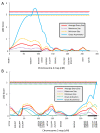Support for the reproductive ground plan hypothesis of social evolution and major QTL for ovary traits of Africanized worker honey bees (Apis mellifera L.)
- PMID: 21489230
- PMCID: PMC3100260
- DOI: 10.1186/1471-2148-11-95
Support for the reproductive ground plan hypothesis of social evolution and major QTL for ovary traits of Africanized worker honey bees (Apis mellifera L.)
Abstract
Background: The reproductive ground plan hypothesis of social evolution suggests that reproductive controls of a solitary ancestor have been co-opted during social evolution, facilitating the division of labor among social insect workers. Despite substantial empirical support, the generality of this hypothesis is not universally accepted. Thus, we investigated the prediction of particular genes with pleiotropic effects on ovarian traits and social behavior in worker honey bees as a stringent test of the reproductive ground plan hypothesis. We complemented these tests with a comprehensive genome scan for additional quantitative trait loci (QTL) to gain a better understanding of the genetic architecture of the ovary size of honey bee workers, a morphological trait that is significant for understanding social insect caste evolution and general insect biology.
Results: Back-crossing hybrid European x Africanized honey bee queens to the Africanized parent colony generated two study populations with extraordinarily large worker ovaries. Despite the transgressive ovary phenotypes, several previously mapped QTL for social foraging behavior demonstrated ovary size effects, confirming the prediction of pleiotropic genetic effects on reproductive traits and social behavior. One major QTL for ovary size was detected in each backcross, along with several smaller effects and two QTL for ovary asymmetry. One of the main ovary size QTL coincided with a major QTL for ovary activation, explaining 3/4 of the phenotypic variance, although no simple positive correlation between ovary size and activation was observed.
Conclusions: Our results provide strong support for the reproductive ground plan hypothesis of evolution in study populations that are independent of the genetic stocks that originally led to the formulation of this hypothesis. As predicted, worker ovary size is genetically linked to multiple correlated traits of the complex division of labor in worker honey bees, known as the pollen hoarding syndrome. The genetic architecture of worker ovary size presumably consists of a combination of trait-specific loci and general regulators that affect the whole behavioral syndrome and may even play a role in caste determination. Several promising candidate genes in the QTL intervals await further study to clarify their potential role in social insect evolution and the regulation of insect fertility in general.
Figures





Similar articles
-
The genetic basis of transgressive ovary size in honeybee workers.Genetics. 2009 Oct;183(2):693-707, 1SI-13SI. doi: 10.1534/genetics.109.105452. Epub 2009 Jul 20. Genetics. 2009. PMID: 19620393 Free PMC article.
-
Tyramine and its receptor TYR1 linked behavior QTL to reproductive physiology in honey bee workers (Apis mellifera).J Insect Physiol. 2020 Oct;126:104093. doi: 10.1016/j.jinsphys.2020.104093. Epub 2020 Aug 4. J Insect Physiol. 2020. PMID: 32763247
-
Sensory response system of social behavior tied to female reproductive traits.PLoS One. 2008;3(10):e3397. doi: 10.1371/journal.pone.0003397. Epub 2008 Oct 14. PLoS One. 2008. PMID: 18852894 Free PMC article.
-
8. The development and evolution of division of labor and foraging specialization in a social insect (Apis mellifera L.).Curr Top Dev Biol. 2006;74:253-86. doi: 10.1016/S0070-2153(06)74008-X. Curr Top Dev Biol. 2006. PMID: 16860670 Free PMC article. Review.
-
Genetic underpinnings of division of labor in the honeybee (Apis mellifera).Trends Genet. 2013 Nov;29(11):641-8. doi: 10.1016/j.tig.2013.08.002. Epub 2013 Sep 6. Trends Genet. 2013. PMID: 24012355 Review.
Cited by
-
Complex pleiotropy characterizes the pollen hoarding syndrome in honey bees (Apis mellifera L.).Behav Ecol Sociobiol. 2012 Nov 1;66(11):1459-1466. doi: 10.1007/s00265-012-1400-x. Epub 2012 Aug 22. Behav Ecol Sociobiol. 2012. PMID: 23226916 Free PMC article.
-
Integration of lncRNA-miRNA-mRNA reveals novel insights into oviposition regulation in honey bees.PeerJ. 2017 Oct 5;5:e3881. doi: 10.7717/peerj.3881. eCollection 2017. PeerJ. 2017. PMID: 29018616 Free PMC article.
-
Association between the Microsatellite Ap243, AC117 and SV185 Polymorphisms and Nosema Disease in the Dark Forest Bee Apis mellifera mellifera.Vet Sci. 2020 Dec 29;8(1):2. doi: 10.3390/vetsci8010002. Vet Sci. 2020. PMID: 33383841 Free PMC article.
-
Pleiotropy of segregating genetic variants that affect honey bee worker life expectancy.Exp Gerontol. 2012 Aug;47(8):631-7. doi: 10.1016/j.exger.2012.05.017. Epub 2012 Jun 1. Exp Gerontol. 2012. PMID: 22664574 Free PMC article.
-
The dynamic association between ovariole loss and sterility in adult honeybee workers.Proc Biol Sci. 2017 Mar 29;284(1851):20162693. doi: 10.1098/rspb.2016.2693. Proc Biol Sci. 2017. PMID: 28356452 Free PMC article.
References
-
- West-Eberhard MJ. In: Animal Societies, Theories and Facts. Ito Y, Brown JL, Kikkawa J, editor. Tokyo: Japan Scientific Societies Press; 1987. Flexible Strategy and Social Evolution; pp. 35–51.
-
- West-Eberhard MJ. In: Natural History and Evolution of Paper Wasps. Turillazzi S, West-Eberhard MJ, editor. New York: Oxford University Press; 1996. Wasp societies as microcosms for the study of development and evolution; pp. 290–317.
Publication types
MeSH terms
Grants and funding
LinkOut - more resources
Full Text Sources
Research Materials

